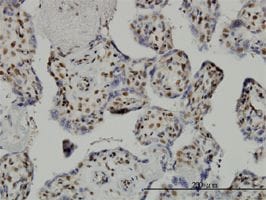Anti-TAF7 antibody (ab57494)
Key features and details
- Mouse monoclonal to TAF7
- Suitable for: WB, IHC-P, Flow Cyt
- Reacts with: Human
- Isotype: IgG2a
Overview
-
Product name
Anti-TAF7 antibody -
Description
Mouse monoclonal to TAF7 -
Host species
Mouse -
Tested Applications & Species
See all applications and species dataApplication Species Flow Cyt HumanIHC-P HumanWB Human -
Immunogen
Recombinant fragment: FIWNHGITLP LKNVRKRRFR KTAKKKYIES PDVEKEVKRL LSTDAEAVST RWEIIAEDET KEAENQGLDI SSPGMSGHRQ GHDSLEHDEL REIFN, corresponding to amino acids 130-224 of Human TAF7
-
General notes
This product was changed from ascites to tissue culture supernatant on 12th June 2019. Please note that the dilutions may need to be adjusted accordingly. If you have any questions, please do not hesitate to contact our scientific support team.
The Life Science industry has been in the grips of a reproducibility crisis for a number of years. Abcam is leading the way in addressing the problem with our range of recombinant monoclonal antibodies and knockout edited cell lines for gold-standard validation.
One factor contributing to the crisis is the use of antibodies that are not suitable. This can lead to misleading results and the use of incorrect data informing project assumptions and direction. To help address this challenge, we have introduced an application and species grid on our primary antibody datasheets to make it easy to simplify identification of the right antibody for your needs.
Learn more here.
Properties
-
Form
Liquid -
Storage instructions
Shipped at 4°C. Upon delivery aliquot and store at -20°C or -80°C. Avoid repeated freeze / thaw cycles. -
Storage buffer
pH: 7.4 -
 Concentration information loading...
Concentration information loading... -
Purity
Tissue culture supernatant -
Clonality
Monoclonal -
Isotype
IgG2a -
Light chain type
kappa -
Research areas
Images
-
TAF7 antibody (ab57494) at 1ug/lane + MCF-7 cell lysate at 25ug/lane.
This image was generated using the ascites version of the product.
-
Overlay histogram showing HeLa cells stained with ab57494 (red line). The cells were fixed with 4% paraformaldehyde (10 min) and then permeabilized with 0.1% PBS-Tween for 20 min. The cells were then incubated in 1x PBS / 10% normal goat serum / 0.3M glycine to block non-specific protein-protein interactions followed by the antibody (ab57494, 1μg/1x106 cells) for 30 min at 22°C. The secondary antibody used was DyLight® 488 goat anti-mouse IgG (H+L) (ab96879) at 1/500 dilution for 30 min at 22°C. Isotype control antibody (black line) was mouse IgG2a [ICIGG2A] (ab91361, 1μg/1x106 cells) used under the same conditions. Unlabelled sample (blue line) was also used as a control. Acquisition of >5,000 events were collected using a 20mW Argon ion laser (488nm) and 525/30 bandpass filter.
This image was generated using the ascites version of the product.
-
TAF7 antibody (ab57494) used in immunohistochemistry at 1ug/ml on formalin fixed and paraffin embedded human lymph node.
This image was generated using the ascites version of the product.
-
 Western blot - Anti-TAF7 antibody (ab57494) Image kindly supplied by Dr Karin Birkenkamp-Demtroeder through AbreviewLane 2 : Anti-TAF7 antibody (ab57494) at 1/1250 dilution
Western blot - Anti-TAF7 antibody (ab57494) Image kindly supplied by Dr Karin Birkenkamp-Demtroeder through AbreviewLane 2 : Anti-TAF7 antibody (ab57494) at 1/1250 dilution
Lane 3 : Anti-TAF7 antibody (ab57494) at 1/2500 dilution
Lane 4 : Anti-TAF7 antibody (ab57494) at 1/5000 dilution
Lane 5 : Anti-TAF7 antibody (ab57494) at 1/10000 dilution
All lanes : whole cell lysate prepared from SW780 badder cancer cells
Lysates/proteins at 25 µg per lane.
Secondary
All lanes : Goat anti-mouse IgG conjugated to HRP
Developed using the ECL technique.
Performed under reducing conditions.
Predicted band size: 40 kDa
Observed band size: 40 kDa
Additional bands at: 90 kDa. We are unsure as to the identity of these extra bands.
Exposure time: 10 minutesLane 1: All Blue Biorad.Gel run under denaturing conditions with a 4-12% gradient.Blocking step performed using 5% milk for one hour at room temperature.Primary antibody incubated for 16 hours.
This image was generated using the ascites version of the product.
-
 Immunohistochemistry (Formalin/PFA-fixed paraffin-embedded sections) - Anti-TAF7 antibody (ab57494) This image was kindly supplied by Dr Karin Birkenkamp-Demtroeder by Abreview
Immunohistochemistry (Formalin/PFA-fixed paraffin-embedded sections) - Anti-TAF7 antibody (ab57494) This image was kindly supplied by Dr Karin Birkenkamp-Demtroeder by Abreviewab57494 staining TAF7 in human bladder cancer tissue sections by Immunohistochemistry (Formalin/PFA-fixed paraffin-embedded sections). Tissue was fixed with formaldehyde and a heat mediated antigen retrieval step was performed using TEG. Samples were then blocked with 1% serum for 1 hour at room temperature followed by incubation with the primary antibody at a 1/3500 dilution for 1 hour. An undiluted HRP-conjugated goat anti-mouse IgG polyclonal was used as secondary antibody.
This image was generated using the ascites version of the product.
















